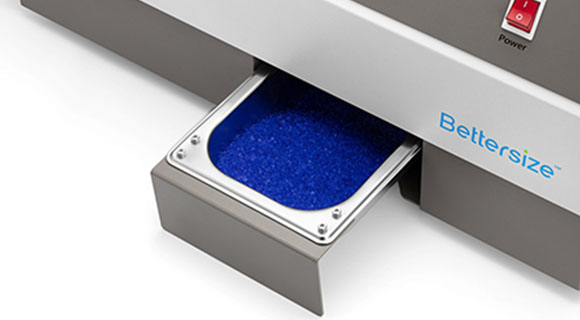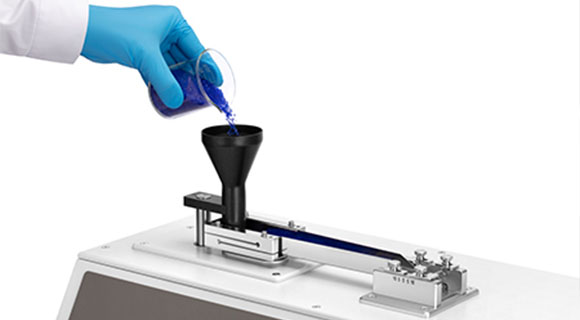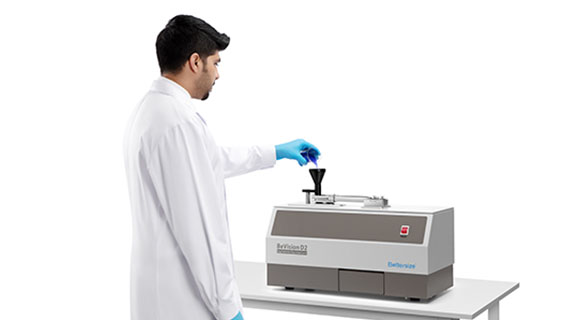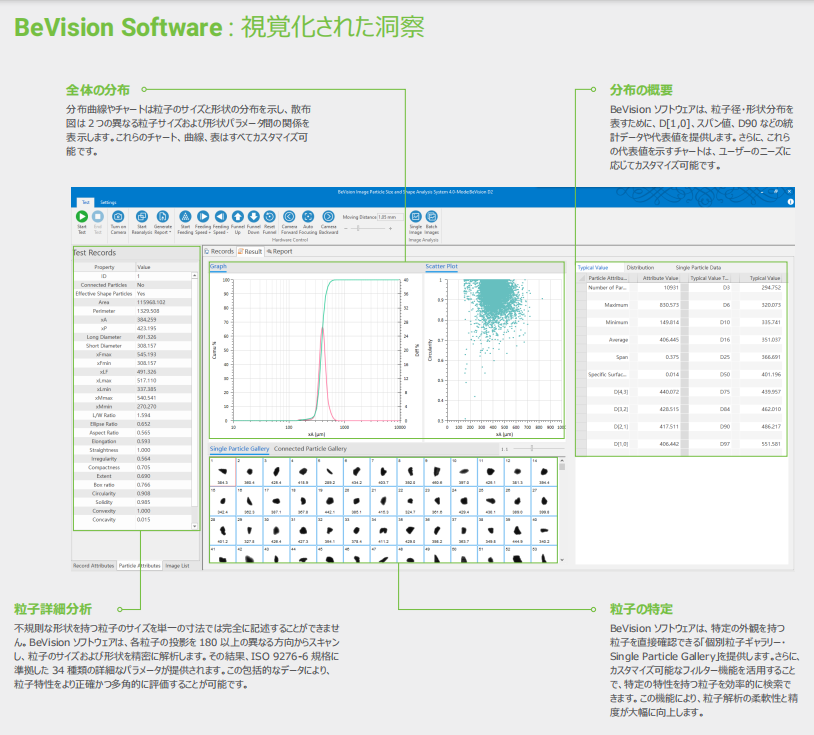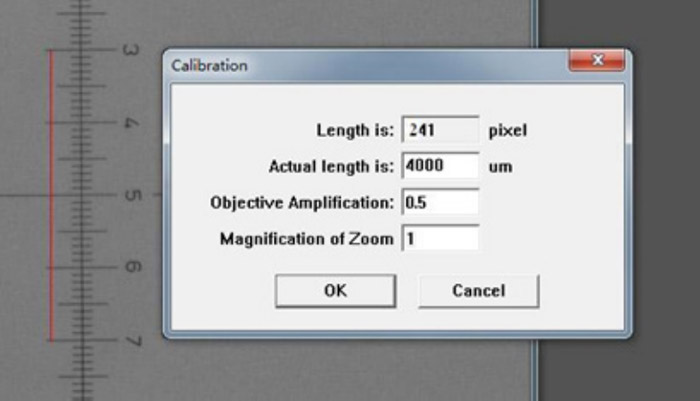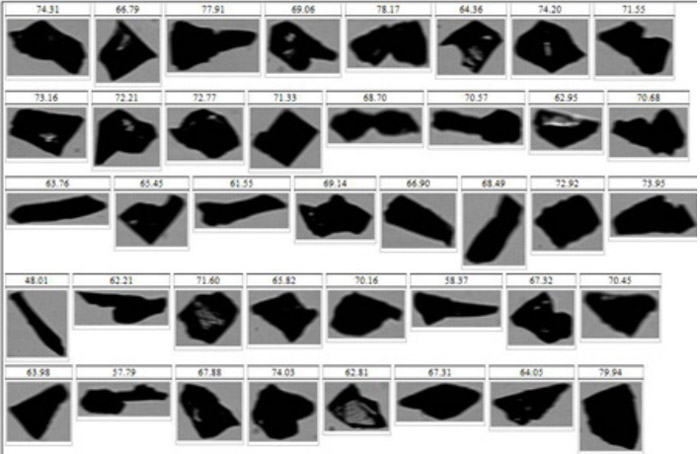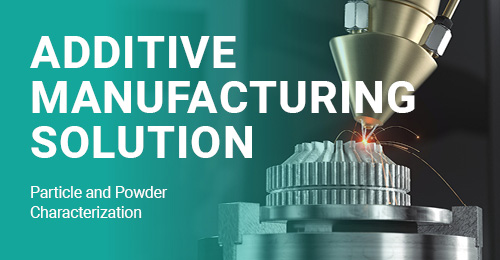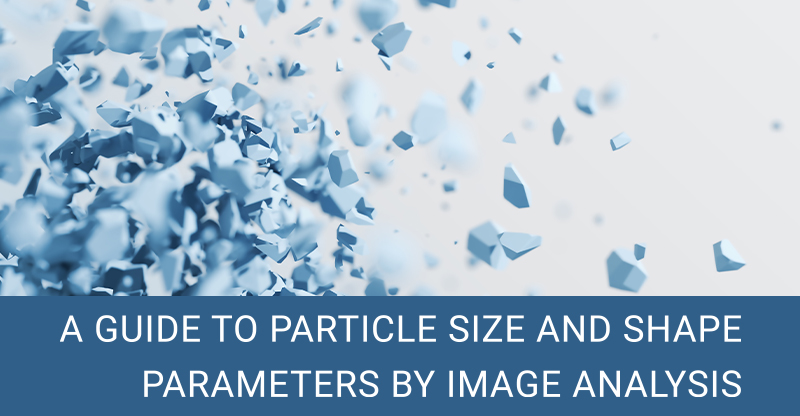BeVision D2 は、乾燥状態の高流動性の粉末や顆粒の粒子径と粒子形態を効率的に分析するための高度なソリューションを提供します。1 回の測定で数万個の粒子をわずか 3 分以内で分析可能です。高速カメラと高精度テレセントリックレンズを組み合わせた独自の設計により、3.5~13,000 μm の広範囲にわたる粒子のサイズと形状を迅速かつ正確に分析します。さらに、専用のBeVisionソフトウェアは、粒子のサイズと形状を 34 の詳細なパラメータで評価します。これにより、取得したデータを体系的に整理し、粒子特性の多面的な検証を可能にします。
機能と利点
- ● 測定範囲 : 3.5 – 13,000 μm
- ● 34種類の粒子径と形状情報を取得
- ● リアルタイムでの測定結果表示
- ● 作業負担と時間の削減
- ● ISO 9276-6 準拠の結果
- ● 完全自動化操作
- ● 強力なソフトウェアによる包括的な評価
- ● 篩分けによる粒子径分布測定結果と高いデータ互換性
ビデオ
How to Install and Operate BeVision D2 
BeVision D2 | A Precise Vision of Particles 
What is Image Analysis? Fundamentals of BeVision Series 
Overview of BeVision Series | Precision in Particle Vision 
概要
動的画像解析装置・乾式測定対応
BeVision D2 は、乾燥状態の高流動性の粉末や顆粒の粒子径と粒子形態を効率的 に分析するための高度なソリューションを提供します。1 回の測定で数万個の粒子をわずか3 分以内で分析可能です。高速カメラと高精度テレセントリックレンズを組み合わせた独自の設計により、3.5 ~ 13,000 μm の広範囲にわたる粒子のサイズと形状を迅速かつ正確に分析しま す。さらに、専用の BeVision ソフトウェアは、サイズと形態に関する合計34項目から粒子を評価します。これにより、取得したデータを体系的に整理し、粒子特性の多面的な検証を可能にします。
装置概要・メリット
- 並行処理技術:リアルタイムでの測定結果表示が可能。
- 高速CCDカメラ:120 FPSの画像出力と超短時間露光機能により、被写体ブレを防止。
- 粒子の自動識別機能:重なり合う粒子を自動的に識別し、測定精度を向上。
- 高効率サンプラーシステム:電磁フィーダーにより試料を振動させて自然落下させ、測定エリアに供給。特に大粒子の測定に最適。
- 篩分けとのデータ互換性:粒子径分布測定結果は、篩分けとの高い互換性を持ちます。
測定可能な項目
-
粒子径解析パラメータ
等価直径(Equivalent diameters): 投影面積円相当径、投影周長円相当径;
フェレー径(Feret diameters):フェレー最大径、フェレー最小径;
マーチン径(Martin diameters):マーチン最大径、マーチン最小径;
ルジャンドルの慣性楕円(Legendre ellipse):ルジャンドルの慣性楕円の長軸、ルジャンドルの慣性楕円の短軸;
-
粒子形状解析パラメータ
2方向の解析:アスペクト比(aspect ratio)、縦横比(L/W ratio)、楕円比(ellipse ratio)
真円度と矩形度: 円形度(Circularity)、不規則性(irregularity)、コンパクト度(compactness)、エクステント(extent)、かさ指数(box ratio);
輪郭の凹凸: 凹み度(Concavity)、凸度(convexity)、充実度(solidity);
細長い粒子:長短度(Elongation)、直線度(straightness);
BeVisionソフトウェア
アプリケーション例
天然砂
さまざまな業界の研究者、特に石油・ガス業界では、土壌や堆積物の形態学的情 報が非常に重要です。天然砂は粒度や形状が広範囲にわたって分布しており、成形 プロセスの効率にも影響を与えるため、画像解析装置にとって大きな挑戦となります。 BeVision D2 は、広範囲の測定と高い効率を兼ね備え、これらの課題を解決します。 中国石油大学の研究チームは、BeVision D2 を使用し、天然砂サンプルの粒度と形 状を高精度で測定することに成功しました。
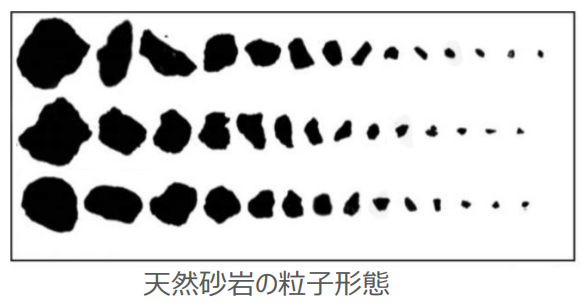
穀物
穀物、特に精製された穀物のサイズと形状は、最終製品の品 質と価値に大きな影響を与えます。穀物のサイズと形状を正確 に監視するために、BeVision D2 は高解像度で効率的なソ リューションを提供します。粒子径 (xA) と円形度の関係を示 す散布図は、品質管理の担当者様が米粒サンプルのサイズ・ 形状分布を適切に管理し、割れ米や不純物の含有量を測定 するのに役立ちます。
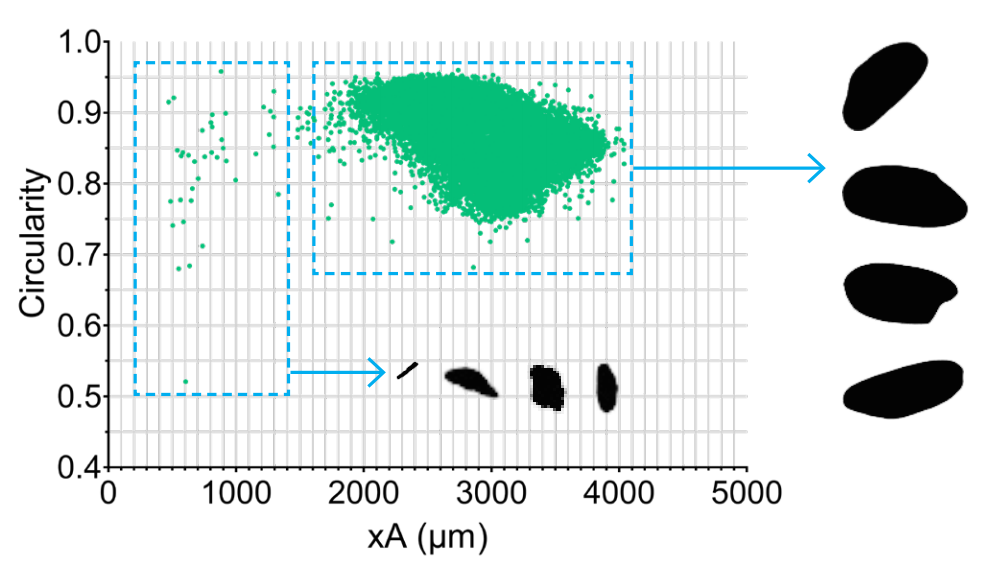
応用分野
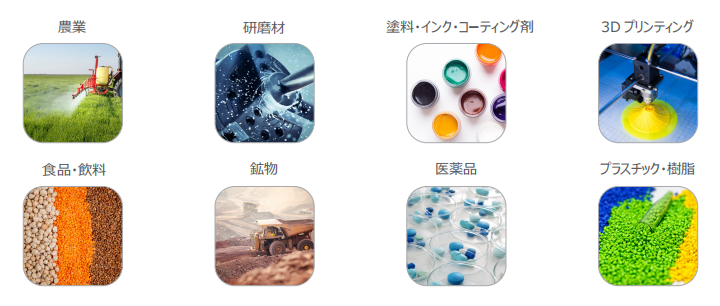
Citations
- Bettersizer 2600
Functional redundancy as an indicator for evaluating functional diversity of macrobenthos under the mussel raft farm near Gouqi Island
DOI: 10.1016/j.aquaculture.2023.740024 Read ArticleZhejiang Ocean University | 2024Biological traits analysis (BTA) helps to evaluate the effects of different environmental variables on the traits-based functional composition of macrobenthos. However, research on functional traits of macrobenthos under mussel farming is limited. We investigated the spatial and temporal response of the benthic system in terms of taxonomic and functional diversity to environmental variables of farming and natural stressors resulting from suspended mussel farming near Gouqi Island of eastern China Sea. The functional traits of macrobenthic assemblages under mussel farming were characterized by “medium adult body size”, “vermiform body form”, “high flexibility”, “infauna”, “semi-motile”, “gonochoristic”, “surface deposit-feeders”, “carnivores”, “semi-motile burrowers”, and “tube-dwellers”. Functional redundancy was stable in response to mussel farming stresses among seasons, whereas species diversity showed efficient to evaluate natural variables. Functional diversity was significantly affected by farming stressors rather than natural variables, Further analysis using multivariate methods together with continuous monitoring were highlighted to evaluate the impacts of mussel farming. Our results reinforce the importance of macrobenthic species and functional traits analysis to evaluate human stresses driven impacts in offshore ecosystems. By analysing the environmental variables with different sources, independently, we concluded the main effects of human pressures on macrobenthic community. Such distinction could be particularly effective to isolate variable environmental descriptors and evaluate their effects on functional diversity, making the current approach promising for the evaluation of ecological effects of anthropogenic stressors in aquaculture areas. - Bettersizer 2600
Degradation characteristics and utilization strategies of a covalent bonded resin-based solid amine during capturing CO2 from flue gas
DOI: 10.1016/j.seppur.2023.125621 Read ArticleChina University of Petroleum | 2024In this study, various types of degradation as well as attrition which are possibly encountered in a circulating fluidized bed temperature swing adsorption (CFB-TSA) process, were conducted experimentally to evaluate the stability of a resin-based solid amine sorbent. Other characterizations methods, such as elemental analysis (EA), Fourier transform infrared spectroscopy (FTIR) etc. were applied to further reveal the degradation mechanisms. The results showed that thermal degradation occurs from 140–160 °C due to the decomposition of amine group. The CO2-induced degradation occurs from a higher temperature of 160–180 °C accompanied by the production of urea. Hydrothermal stability is good below 130 °C, but the ionic impurities in steam crystalized on particle surface can accelerate the degradation. Oxidative degradation is the most harmful, which starts at a lower temperature of 70–80 °C with the formation of aldehyde. The existence of H2O in atmosphere can alleviate the oxidative and CO2-induced degradations. The employed sorbent has a very low attrition index of 0.05, which is 1–2 orders lower than typical commercial fluidized bed catalysts. Based on the results of stability evaluation, some design suggestions for proper utilization of this sorbent or other similar resin-based sorbents have been provided in an industrial CFB-TSA process.
- Bettersizer 2600
De-branching of starch molecules enhanced the complexation with chitosan and its potential utilization for delivering hydrophobic compounds
DOI: 10.1016/j.foodhyd.2023.109498 Read ArticleShihezi University | 2024The current study aimed to prepare the complexes between debranched-waxy corn starch and chitosan polymers (DBS-CS), and then investigated their corresponding structural characteristics, rheological property and potent application in Pickering emulsion. The results indicated that the existence of chitosan significantly inhibited starch short-range molecular rearrangement for all DBS-CS samples, which was manipulated by both debranching treatment and chitosan content. Interestingly, this is the first study to reveal that the outstanding peak at 1.8 ppm in 1H NMR spectrum for sample DBS-CS was gradually shifted towards a lower-field region following an increased chitosan content. Moreover, the debranching treatment shifted the crystallinity pattern from A-type to B-type and the relative crystallinity of DBS-CS decreased gradually with the increased content of CS. All samples had a pseudoplastic fluid and shear-thinning behavior with an enhanced shear resistance following the complexation. The DBS-CS was applied in a Pickering emulsion for showing a greater emulsifying stability and a lower gel strength than native NS-CS prepared emulsion. Importantly, the encapsulation ability of curcumin in the DBS-CS emulsion was significantly improved, followed by an increase of 15.45% for its corresponding bioavailability compared to the control. Therefore, this study might highlight a potential carrier for delivering the bioactive substances in a green pattern. - Bettersizer 2600
Heat-induced aggregation behavior of wheat gluten after adding citrus pectin with different esterification degree
DOI: 10.1016/j.foodhyd.2023.109420 Read ArticleGansu Agricultural University | 2024Wheat gluten aggregation during heat treatment is beneficial to the final quality of gluten-based products. Exogenous pectin can affect gluten aggregation. However, the effect of pectin with different degrees of esterification on the heat-induced aggregation behavior of gluten and its possible mechanism are still unclear. Thus, the heat-induced aggregation behavior of gluten after adding pectin with different esterification degree was studied in this study. When the temperature was raised from 25 °C to 95 °C, pectin affected gluten aggregation and was related to the degree of esterification. Specifically, the results of rheological properties and particle size indicated that low-ester pectin improved the viscoelasticity of gluten and promoted gluten aggregation. Thermal properties revealed that enthalpy of gluten added with low-ester pectin (37%) increased from 92.96 J/g to 95.40 J/g during heating process. Structurally, the fluorescence intensity and surface hydrophobicity of gluten added with low-ester pectin (37%) were lower than those added with high-ester pectin (73%). In addition, low-ester pectin (37%) significantly increased the disulfide bond content (from 15.31 μmol/g to 18.06 μmol/g) and maintained β-sheet content of gluten compared with gluten alone at 95 °C, indicating that low-ester pectin was more likely to induce gluten aggregation. However, scanning electron microscope showed that the gluten added with low-ester pectin (46%) exhibited a denser network structure at 95 °C than that added with low-ester pectin (37%). These results will provide a theoretical base for the regulation of gluten aggregation and the quality of gluten-based products by pectin with different esterification degree.
- 1
- 2
- 3
- 4
- 5
- 6
- 84


